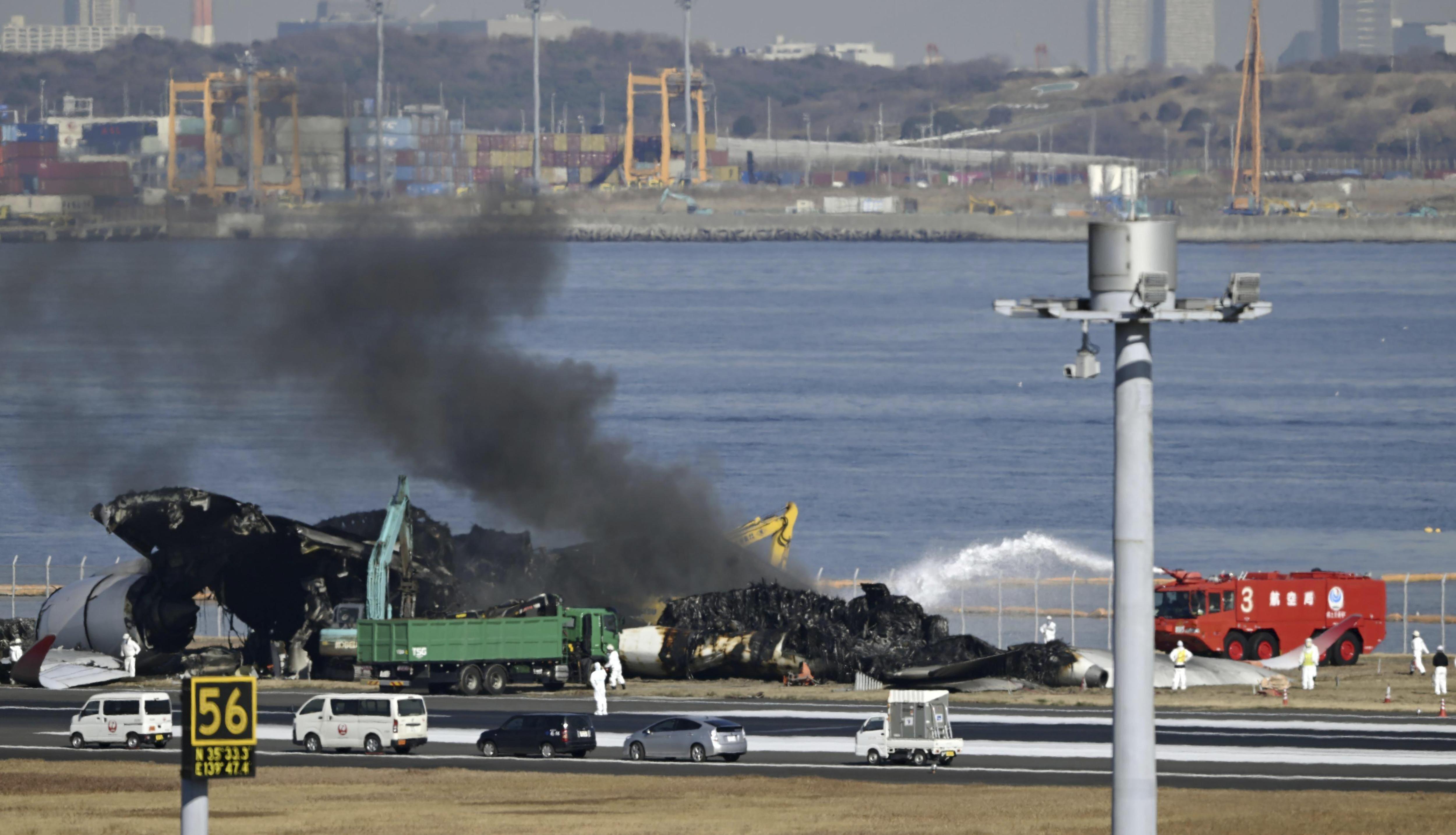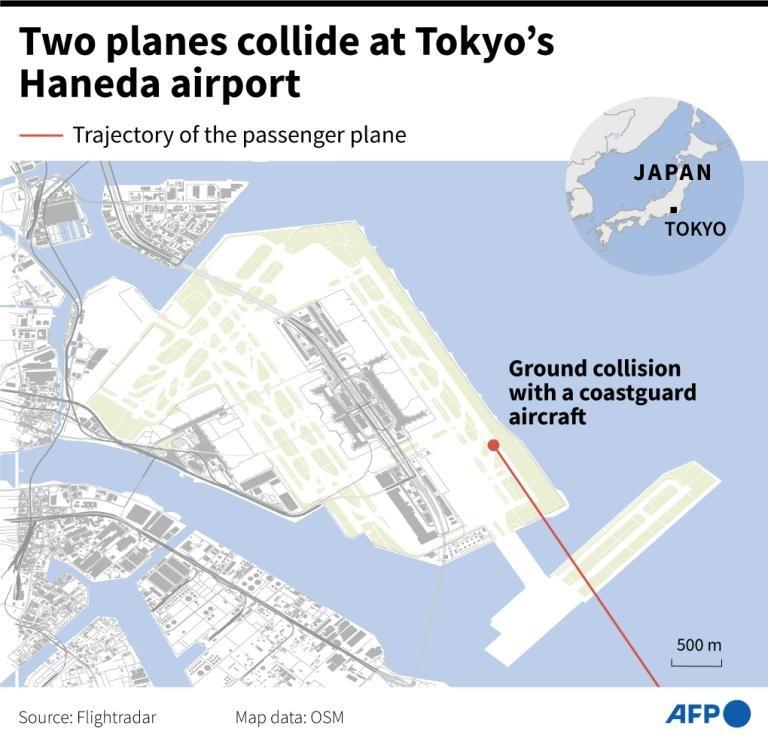 Black smoke rises while removal work is underway at the site of a plane collision at Haneda airport in Tokyo, Jan 5, 2024. Cranes were dismantling the Japan Airlines Flight 516 Airbus A350 that caught fire after hitting a Coast Guard aircraft while it was landing at the airport on Tuesday. (KYODO NEWS VIA AP)
Black smoke rises while removal work is underway at the site of a plane collision at Haneda airport in Tokyo, Jan 5, 2024. Cranes were dismantling the Japan Airlines Flight 516 Airbus A350 that caught fire after hitting a Coast Guard aircraft while it was landing at the airport on Tuesday. (KYODO NEWS VIA AP)
TOKYO – Crews at Tokyo's Haneda Airport began clearing the charred wreck of a Japan Airlines plane from a runway on Friday, as investigators sought to retrieve the aircraft's cockpit voice recorder and discover what caused the deadly accident.
The Japan Airlines passenger jet collided with a Coast Guard turboprop on the runway while landing in Tokyo on Tuesday. All 379 people on the JAL aircraft escaped before it was engulfed in flames, but five of the six crew on the Coast Guard craft died.
Two excavators equipped with cutting equipment ripped off the Airbus A350's wing, while another lifted debris from inside the burnt out cabin into a large lorry as around a dozen personnel in white overalls and hard hats watched on.
READ MORE: Runway safety concerns in focus as Japan probes Tokyo crash
An official from the Japan Transport Safety Board said the plane's flight data recorder had been collected earlier this week but that the cockpit voice recorder had still not been retrieved.
Officials aim to complete the removal of the wreckage by Jan 7 and it will be taken to its hangar, where the aircraft will be inspected by the Tokyo Metropolitan Police Department, broadcaster TBS reported.
US officials will provide assistance to Japan in reading the airplane recorders to get a clearer idea about the cause of the deadly collision
Transport authorities are probing the circumstances that led to the Coast Guard plane entering the runway where the passenger jet was landing while, according to media reports, police are looking into possible professional negligence.
The captain of the Coast Guard aircraft, the sole survivor, is under scrutiny after authorities released control tower transcripts appearing to show he was ordered to enter a holding area near the runway before the crash occurred.
He said he had permission to enter the runway, the Coast Guard said on Wednesday, acknowledging there was no indication of that in the transcripts.
The captain suffered severe burns as a result of the crash and could not be reached for comment.
Emergency trip
The Coast Guard plane was making its third emergency trip to an earthquake zone within 24 hours when the collision occurred. On the day of the accident, Haneda, the world's third busiest airport, was at full capacity, authorities have said.
ALSO READ: Japan crash marks test of how new carbon jets cope in a disaster
Authorities have only just begun their investigations and aviation experts say it usually takes the failure of multiple safety guardrails for an airplane accident to happen.
The Coast Guard plane was on the runway for 40 seconds before the crash, local news outlets reported.
 Map showing Tokyo's Haneda airport, and key details on the collision of two planes on Jan 2. (GRAPHIC / AFP)
Map showing Tokyo's Haneda airport, and key details on the collision of two planes on Jan 2. (GRAPHIC / AFP)
A Civil Aviation Bureau official said they were aware of the reports but hadn't confirmed it. "We are checking it currently," the official said.
The collision marked the first time a modern lightweight airliner has burnt down and is being seen as a test case for how well a new generation of carbon-composite airplanes copes with a catastrophic fire.
US assistance on airplane recorders
US aviation safety officials will provide assistance to Japan in the reading of airplane recorders after a deadly collision between a Japan Airlines widebody jet and a small Coast Guard plane this week.
TSB Chair Jennifer Homendy told reporters Japan had sought assistance with the Honeywell-manufactured recorders. "We will help on that," she said, adding it is unclear if the recorders will be brought to Washington for analysis or if NTSB personnel will travel to Japan to offer assistance.
A Honeywell spokesperson said it produced the cockpit voice recorder used on the Canadian-made Dash-8, but not the flight data recorder.
READ MORE: Japan releases transcripts of fatal aircraft collision
L3Harris confirmed it produced recorders for both the A350 and the Dash-8, but referred further questions about the investigation to the NTSB and Japanese authorities.
The JTSB declined to comment on the issue of US assistance.
Under international rules for aircraft investigations, known throughout the industry by their legal name "Annex 13," the probe is led by the country where the crash took place, but countries where the planes are manufactured can also participate.
Forensic experts from Airbus and French state agency BAE, along with a representative from Canada's Transportation Safety Board are investigating the accident, which killed five of the six Coast Guard plane crew members.
Japan, which is leading the investigation, can also ask other countries for assistance under international rules.


